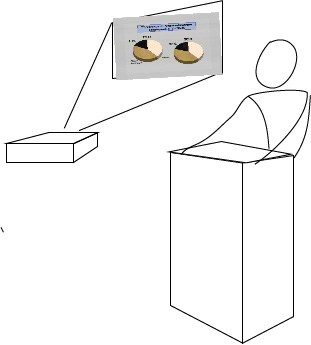 Legal visuals work. We thought so, and now we have the statistical rigor of a controlled experiment to prove it.
Legal visuals work. We thought so, and now we have the statistical rigor of a controlled experiment to prove it.
In a study comparing opening arguments delivered with and without simple PowerPoint visuals, mock jurors were persuaded more often when the slides were used. The study found effects on persuading jurors, recollection of evidence and perceptions of the advocates. With respect to persuading jurors, the study’s authors wrote in the summary:
“In general, defendant’s responsibility was judged to be greater when plaintiffs used PowerPoint slides than when they did not and less when defendant used PowerPoint slides than when it did not. Furthermore, PowerPoint’s impact was greatest when its use was unequal [only one side using PowerPoint].”
Below, we’ll look more closely at the study and what it teaches us about using visuals in court.
The Study
The study is “Effects of a Visual Technology on Mock Juror Decision Making,” 2013, Applied Cognitive Psychology, 27, 235-246,” published by a professor of psychology at Baruch College, Jaihyun Park, and a professor of law at Quinnipiac University, Neal Feigenson.
Using a discrimination case modeled on a real case, the professors videotaped oral arguments with and without PowerPoint slides, and presented those videotaped arguments to mock jurors drawn from undergraduates at a university. 
The slides used in the study were very simple: six slides per side (4 slides presenting statistical evidence and 2 illustrating other arguments). One of the slides is shown, and the remaining slides used and sections of the accompanying spoken argument can be viewed in the study appendix, which is available on Professor Park’s biography page here.
After the jurors viewed the presentation, they were asked to decide if defendant was liable or not. The jurors were also asked other questions such as the degree of defendant’s responsibility, their assessments of counsel, and their recall of details from the arguments.
The Slides Persuaded Jurors, Improved Evidence Recall and Improved Perception of Advocates
The slides gave an advantage to the side using the visuals. For example, the study found:
- “The percentage of participants who found the defendant liable was the highest (48%) when the plaintiffs used visuals but the defendant did not, and the lowest (26%) when the plaintiffs did not use visuals but the defendant did.” (Study at 237).
- Use of slides by the defendant helped the jurors recall the defendant’s statistical evidence correctly.(Study at 238).
- “When defendant used visuals, the defendant’s lawyer was judged better prepared, more competent and more credible than when defendant did not use them.” (Study at 238, internal statistical summaries omitted).
Not every test yielded statistically significant results, and sometimes the results showed results favoring one side without a measurable effect on the other. For example, as noted above, defendant’s use of visuals enhanced perception of the preparedness of defendant’s attorney. However, plaintiff’s use of visuals did not have a measurable effect on perception of the plaintiff’s attorney.
Exploration of How the Visuals Persuaded Jurors
The study went beyond looking for evidence of persuasion, and additionally analyzed how and why jurors were persuaded. Specifically, the study analyzed the results using the Elaboration Likelihood Model of persuasion, which posits that a message can succeed in convincing a listener by one of two paths—a cognitive path (the user is persuaded as she thinks about, processes and evaluates the message); and a peripheral path (the user is persuaded without cognitive processing of an argument’s merits, e.g., through perceptions that the speaker is credible and/or attractive).
The study concluded that visuals persuaded jurors in both ways: (1) helping them think through the arguments (a cognitive path under the Elaboration Likelihood Model) and (2) by providing cues that persuaded without involved thinking through of the message (a peripheral path under the Elaboration Likelihood Model). For example, the study found that the visuals helped the jurors recall details about evidence, and that this effect contributed to persuasion on a cognitive path. The visuals also persuaded by peripheral cues such as convincing jurors that the attorney was more credible.
Some Thoughts and Take-Aways from the Study
A few closing thoughts about the study:
- It is difficult to study persuasion scientifically. The study goes to great lengths to set up a controlled experiment, and then to measure and analyze the results statistically. It is not surprising that most evidence about visual aids and other persuasive techniques is anecdotal.
- A scientific study about persuasion is difficult for a lay reader to understand. The study is not easy reading. I took statistics many years ago, and even a partial understanding of this study took me many visits to Wikipedia entries to remind myself of terminology. Here is a link to my statistics notes should they be helpful to you.
- Your results will vary. As an attorney specializing in litigation graphics, I immediately began to think about how the visuals and arguments used could have been improved. (As noted above, those visuals and arguments are in the study appendix here.) The study’s authors also note that their results came from “relatively few slides of mostly simple design” and that “[s]tronger effects might well be created by more extensive displays.” (Study at 244.)
For ideas on how to create effective PowerPoint slides and other visuals for your case, I suggest you read this earlier post, Five Essential PowerPoint Tips for Attorneys, and browse our portfolio of sample graphics.
If you’d like to receive updates from this blog, please click to subscribe by email.

